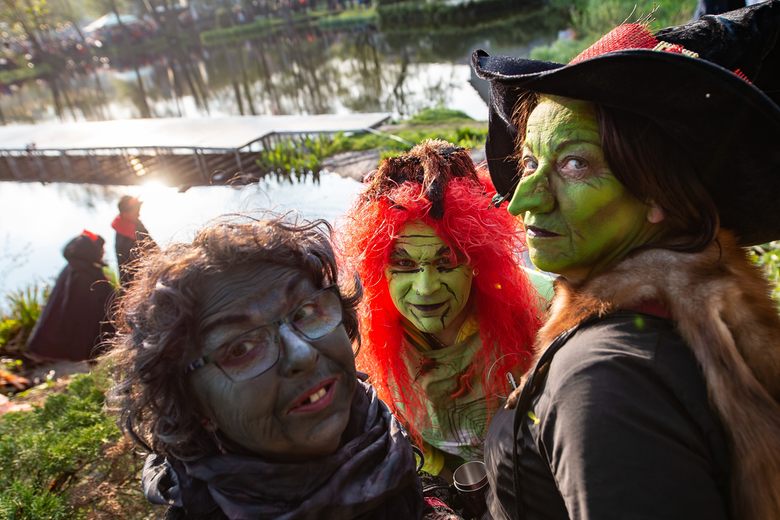
A 60-mile journey in northern Germany explores eerie legends, industrial history, and recovering forests post-devastating pest
The inscription on the wooden shelter, where I paused to enjoy my Käsebrötchen, offered a bold vow. It read, “Wanderer,” as Google Translate suggested, “I shield you from the elements, a guardian against malicious intentions.” Exaggerated? Maybe, but such reassurance is necessary when lingering with cheese rolls in these eerie surroundings
A shelter was initially constructed at this location to serve as a resting point for medieval donkey drivers transporting goods from the nearby town of Osterode to the mines in the Harz Mountains of northern Germany. Today, this newer structure serves the same purpose, but for hikers like myself, who are following the Harzer Hexen-Stieg (Harz Witches’ Trail).
It’s hard to resist a trail with a name like that, isn’t it? This name is rooted in centuries of local folklore and happens to be on trend nowadays, with “witch lit” gaining popularity. In 2023, top titles like Emilia Hart’s ‘Weyward’ and Margaret Meyer’s ‘The Witching Tide’ have emerged, and a movement of older women is reclaiming the term “crone.” Moreover, it felt like an ideal choice for an autumn adventure. The well-maintained 60-mile route from Osterode to Thale, typically completed in four to six days, promised relatively dry paths, misty ambiance, cozy inns, hearty pork dinners each evening, and the unfolding of ghostly tales. What I encountered was truly captivating and haunting in ways I hadn’t expected
I departed Osterode around noon, with the backdrop of church bells ringing above the lively market square filled with buskers, butchers, florists, and fishmongers. It didn’t take long to realize that the people in this area had fully embraced the witching theme, with pointy-hatted figures peering from many gardens and window ledges.
However, as I ventured into the countryside, the focus shifted to the region’s rich industrial history. The Upper Harz is among Europe’s oldest and most significant mining regions, having been active in silver, lead, and copper mining since the early 13th century. It is now recognized as a UNESCO World Heritage site. The mining operations were powered by an impressive network of 107 ponds, 195 miles of ditches, and 19 miles of waterways. The witches’ trail follows some of these water features, including crossings of ancient dams and streams, and paths flanked by berry bushes.
One of my favorite remnants of this industrial heritage was in Altenau, where I spent my first night at the Landhaus am Kunstberg guesthouse. Here, one of the ponds has been transformed into Waldschwimmbad Okerteich, a vast, forest-fringed wild swimming pool that remains open year-round, free of charge, although the water can be quite chilly. Taking a pre-breakfast dip, with only the wagtails as witnesses to my yelps, prepared me for the next day’s hike.”
I also enjoyed the rest of Altenau. The beginnings of tourism in this area can be traced back to the late 19th century, leaving behind a legacy of charming villas. The town’s main street boasts a bakery, brewery, a model train store, and shops offering various witch-related items. From this point, the trail aligns with the Goetheweg, which retraces the path taken by the renowned German writer Johann Wolfgang von Goethe. It was on this trail that Goethe first ascended the nearby 1,141-meter Brocken mountain in December 1777. Over multiple visits, this landscape became a source of inspiration for his literary works, notably “Faust,” in which the Harz Mountains’ highest peak serves as the playground for reveling witches.
The Brocken mountain continues to exude an eerie atmosphere for various reasons. Not only is it enveloped in mist on up to 300 days of the year, but it was also shrouded in secrecy for a long time. The division of East and West Germany cut through this region, and after the construction of the Berlin Wall, East German authorities closed off the Brocken’s summit plateau and used its powerful communication towers for espionage in Western Europe. During my walk, I passed by remnants of the concrete barrier and encountered a stone memorial with an inscription that marked the moment in December 1989 when Germans regained access to their mountain, proclaiming, “Brocken Free Again!”
These days, the most unsettling aspect of the Brocken and the western Harz region lies in its forests. I was unprepared for the extensive damage caused by the bark beetle, which has left an eerie imprint on the landscape. In some areas, it resembles a scene from Halloween, with hillsides covered in rows of skeletal spruce trees, while in other places, desolate stumps stand among the groundsel and willowherb. The impact of the climate crisis has made non-native spruce trees, which were planted in monoculture patterns for centuries, increasingly vulnerable to attacks by these beetles.
While standing atop the Trudenstein outcrop, named for its resemblance to a Drude, a witch-like figure associated with nightmares, I met a man on vacation from Hamburg. Together, we gazed out at the afflicted landscape. He shook his head with a sense of nostalgia and said, “The Harz was once so incredibly beautiful.



